Real time measurements of the vocal tract resonances
during speech.
Julien Epps, Annette Dowd, John Smith and Joe Wolfe
School of
Physics
The University of New South Wales
Sydney 2052 Australia
Published in: ESCA. Eurospeech97. Rhodes, Greece. ISSN
1018-4074, pp 721-724.
Abstract
The formants of speech sounds are usually attributed to resonances
of the vocal tract. Formant frequencies are usually estimated
by inspection of spectrograms or by automated techniques such
as linear prediction. In this paper we measure the frequencies
of the first two resonances of the vocal tract directly, in
real time, using acoustic impedance spectrometry. The vocal
tract is excited by a carefully calibrated, broad band, acoustic
current signal applied outside the lips while the subject is
speaking. The sound pressure response is analysed to give the
resonant frequencies. We compare this new method (Real-time
Acoustic Vocal tract Excitation or RAVE) with linear prediction
and we report the vocal tract resonances for eleven vowels of
Australian English. We also report preliminary results of using
feedback from vocal tract excitation as a speech trainer, and
its effect on improving the pronunciation of foreign vowel sounds
by monolingual anglophones.
Introduction
In the source and filter model of voiced speech, the resonances
of the vocal tract (the filter) modify the harmonic-rich signal
from the vocal folds (the source). If the pitch of the source
signal is sufficiently low, these resonances give rise to formants:
frequency bands of increased power in the spectrum of the sound
radiated from the lips. (The term formant is sometimes used
to describe both the resonances and the local maxima in the
sound spectrum. We measure the two independently, so we reserve
the terms "resonance" for the former and "formant" for the latter.
We refer to them as (R1,R2,...) and (F1,F2,...) respectively.)
Formants are commonly estimated by inspection of spectrograms,
or by automated routines such as linear prediction (LP). There
is an inherent limitation to the precision of such estimates:
they necessarily include an error which cannot be very much
less than the frequency at which the tract's response is sampled,
i.e. the pitch frequency. This imprecision may not be an important
problem for many applications, especially if the speaker has
a low pitched voice with a fundamental pitch of say 100 Hz
or less. It is more important for higher pitched voices. For
the voices of children and some women, the pitch frequency
may be so high that the formants are poorly defined (Clark
and Yallop, 1990). This is particularly the case when the
pitch frequency is of the order of, or greater than, the frequency
of the first resonance (Sundberg, 1987).
The relatively poor precision in formant estimation obtained
from excitation by the speech signal is usually not a problem
when the signal is used for recognition by human listeners.
Normal spoken and written languages have a high level of internal
redundancy (Fletcher, 1992) and so, with appropriate semantic
and linguistic context, high word recognition rates may be
achieved with poor resolution of the vowel formants, or sometimes
even in the [k-mpl-t -bs-ns -v v--lz]. If automated recognition
systems are to identify phonemes successfully without contextual
clues, greater precision in formant or resonance estimation
would be useful.
Speech training is another application which requires precise
measurements in real time. People with very poor or no hearing
have difficulty learning accurate speech because they lack
auditory feedback. Adults learning foreign languages rarely
acquire good accents because their auditory feedback is complicated
by categorisation and interference: they interpret a foreign
phoneme in terms of one in their native language and then
reproduce a sound more like that with which they are familiar.
A real time system which measures accurately the relevant
articulatory properties of the vocal tract can be used to
give feedback which is not compromised by categorisation and
interference (Dowd et al, 1996).
Other investigators have used various methods to determine
vocal tract resonances with higher precision than that available
from voiced speech excitation. Pham Thi Ngoc and Badin (1994)
report measurements made by exciting the tract mechanically
near the glottis. This technique is good for measuring the
vocal tract transfer function, but is perhaps less suitable
for application to speech training because it is a little
invasive and because it is also possible that phonation during
such stimulation is not the same as phonation in the absence
of external mechanical excitation. The resonances may also
be determined from the spectrum of whispered speech, but the
signal is noisy and unpredictable, so time averaging is necessary
for precise measurement (Pham Thi Ngoc, 1995; Dowd, 1995).
We describe a system for rapidly, precisely and non-invasively
measuring the resonances of the vocal tract during phonation,
its application in the measurement of resonances for 11 vowels
in Australian English, and the preliminary results of using
feedback from vocal tract excitation as a speech trainer.
Materials and Methods
Impedance spectrometer. The measurements use a development
of an acoustic impedance spectrometer described by Wolfe et
al (1995); Wolfe and Smith (1995). A signal which comprises
the sum of several hundred sine waves is synthesized by a computer,
converted to an analogue signal, amplified and input to an enclosed
loudspeaker connected to the large end of an exponential horn.
Near the other end of the horn (the source) is a small microphone
(Fig 1), and both are positioned just outside the subject's
lips, with a hemi-cylindrical cowl touching the face just below
the nose. The signal is calibrated with a reference acoustic
load: in this case it is the free field near the subject's mouth,
with the subject's face (mouth closed) and the cowl acting as
baffles. During calibration, the amplitude of each of the sine
waves is adjusted so that the resulting spectrum measured by
the microphone with the subject's mouth closed is independent
of frequency or "flat". When the subject opens his/her mouth
to speak, the vocal tract is in parallel with the acoustic field
and its resonances appear as maxima followed by steep falls
in the broad band response, as shown in Figs 2c and 2d. To determine
these from the total signal, the speech signal is removed. This
is done by measuring its pitch (using a high order low pass
or band pass filter and zero-crossings) and then removing integral
multiples of this frequency (+/- 20 Hz) from the combined signal.
These gaps are filled by interpolation. A routine searches for
the largest negative going discontinuities between levels of
adjacent frequency bands averaged over 25 Hz (for R1) and 100
Hz (for R2). The frequency spacing is about 5 Hz but, because
of the calculations, each cycle takes a little longer than 200
ms and new values for R1, R2 and other data are displayed four
times per second. Technical details and the performance of the
method are described elsewhere (Epps et al, 1997).
Australian vowels. The vocal tracts of 33 young Australian
men (students at the University of New South Wales) were measured.
The acoustic source and microphone were positioned outside
their mouths, with the microphone about 10 mm and the source
about 30 mm from their lips. An instruction sheet asked them
to pronounce and to sustain the words "heed", "hid", "head",
"had", "hard", "hot", "hoard", "hood", "who'd", "hut" and
"heard". 15 measurements were taken for each vowel.
Comparison with Linear Prediction. To compare RAVE
and the standard automated technique of linear prediction
(LP) (Makhoul 1975), we measured the formant frequencies of
one male and one female subject. Linear prediction (LP) is
a spectral smoothing process which fits a curve to the envelope
of the speech signal and reports peaks in the fitted curve.
Subjects were requested to produce the same set of 11 Australian
vowels, in their usual conversational voice, into a microphone.
A 24th order LP model was fitted to their speech in real time,
and the formant frequencies were estimated by calculating
the frequencies of the two lowest-frequency poles of the model.
20 estimates of their first two formant frequencies were recorded
for each vowel sound. The same two speakers were also requested
to produce the same vowels while their vocal tract resonances
were measured using RAVE, as described above.
Speech trainer. The experiment using vocal tract
feedback as a speech trainer used an earlier version of the
spectrometer and software which did not allow phonation. For
this study, subjects were taught to raise the soft palate
(velum) and to mime the production of a vowel. "Target" sounds
were chosen from the French language, as spoken by 5 female
native speakers of the language. The sounds were recorded
on magnetic tape, and the frequencies of the first two resonances
of the tract were measured. 11 monolingual Australian women
volunteers were asked to imitate these target sounds. One
group received only auditory feedback - they listened to the
sounds and attempted to reproduce them. Another group used
both auditory feedback and vocal tract feedback. The latter
consisted of displaying to the subject the acoustic response
of her own vocal tract, upon which was superimposed the values
of the resonant frequencies of the target speaker. Tape recordings
of subjects attempting to imitate the target sounds were distributed
to a listening panel of native speakers who indicated which
vowel they thought that the subject had produced. The procedure
is described in detail in a manuscript submitted elsewhere.
Fig. 1. A synthesized signal containing several hundred
frequency components is input to the amplifier, speaker and
impedance matching horn. The microphone signal includes both
the subject's voice and the response of the vocal tract to
the external signal. The monitor may be used to give the subject
instructions for recording data, or to display visual feedback
about his/her vocal tract.
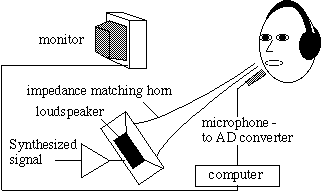
Results
The operation of RAVE on a male and female voice is shown in
examples in Fig. 2. (a) and (b) show the spectrum of the voices
alone, while (c) and (d) show the spectrum measured with both
phonation and external excitation. To compare RAVE with linear
prediction (LP), 20 measurements were made of the resonances
and formants for each of 11 vowels of Australian English as
spoken by one male and one female speaker. The reason for single
subject samples was to minimise intra-sample variation. The
first two resonances were measured using RAVE. The first two
formants were measured using LP. In each case RAVE gave a smaller
variation (Table 1).
Fig. 2 (a) is the magnitude spectrum for a speaker with
pitch frequency 126 Hz. From this, one can estimate formants
at about 0.5 and 1.4 kHz. (b) is the spectrum for the same
vowel spoken by a speaker with pitch frequency 361 Hz. From
this spectrum it is much more difficult to estimate formant
frequencies. The RAVE technique uses a calibrated broad band
source to excite the vocal tract from just outside the lips.
In this example it contains 354 sine waves with frequencies
equally spaced over the range 0.2 to 2.1 kHz. (c) and (d)
show the spectra measured with the vocal tract excited by
the broad band source during pronunciation of the same vowels.
At a modest conversational level, the harmonics of the speaker's
voice are seen above the broad band spectrum at frequencies
less than about 1.6 kHz. The maxima followed by large negative
slopes in the broad band response at 0.4 and 1.3 kHz (in c)
and at 0.5 and 1.1 kHz (in d) are due to the resonances of
the vocal tracts in the configuration for these vowels.
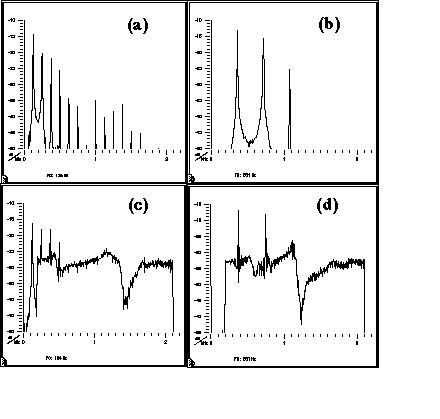
Table 1. The average standard deviations in the formants
(using LP) and the vocal resonances (using RAVE) for 20 measurements
each of 11 Australian vowels.
Male Voice Female Voice
s.d.(F1,R1) s.d.(F2,R2) s.d.(F1,R1) s.d.(F2,R2)
LP 122 240 206 498 Hz
RAVE 64 16 91 31 Hz
Fig. 3. Measurements of the vocal tract resonances
(R2,R1) of 33 young Australian men pronouncing 11 Australian
vowels. The mean (R2,R1) is at the centre of each ellipse and
the semi- axes are the standard deviations. The figure is a
"screen dump" of a version of the RAVE technique used as a speech
trainer, and for that reason only the axes are also labelled
"Position of tongue constriction" and "Jaw opening". These parameters
were not measured directly, but they are correlated with R2
and R1. A cursor on the monitor (the cross at 0.52, 1.20 kHz)
shows the current configuration of the user's own vocal tract
in real time, and the ellipses are used as targets which change
colour when "hit" by the cursor.
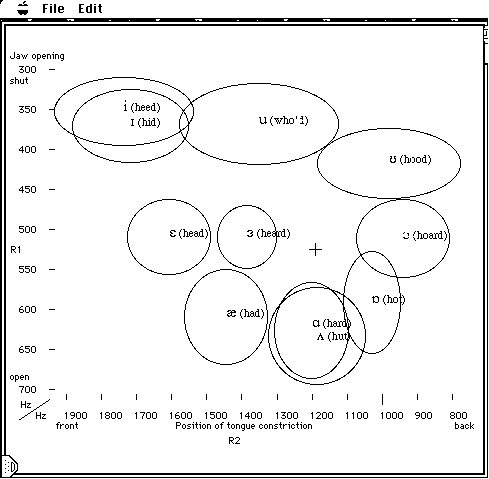
Fig. 3 shows the first two resonances of 11 vowels of Australian
English as measured on 33 Australian men. This figure also
displays the screen used as the application of RAVE to speech
training. In this application, target areas are shown on the
screen, along with the current configuration (R1,R2) of the
user's vocal tract, shown as a moving cursor. The axes are
labelled as jaw position and tongue position respectively
as an initial aid to moving the cursor. After a little training,
users can steer the cursor just by "thinking about where they
want it to go": it is a little like a video game, but with
mouth control rather than a joy stick.
Fig. 4 shows preliminary results from a study to investigate
the use of feedback about the vocal tract as a speech trainer
for foreign language teaching. Six vowels from French were
chosen as targets. These may be considered as three pairs
of vowels which are often confused by non-native speakers.
The vowels in "patte" and "pa^te" are acoustically similar
and are occasionally confused by native speakers. Those in
"paix" and "the' " are also rather similar. Those in
"poux" and "pu" are quite different acoustically. They are
virtually never confused by native speakers of French, but
relatively often confused by English speakers.
Fig. 4. Measurements of the first two vocal tract resonances
by monolingual anglophone subjects attempting to produce six
"target" vowels spoken by native French speakers. The head
of each arrow is the target value, the tail is the average
for the subjects and the semi-axes of the ellipses are the
standard deviations among the subjects. (Short arrows are
good imitations, small ellipses show little variability.)
(a) shows the results for the subjects using auditory feedback
only. (b) shows the results for subjects who had spent one
hour learning vocal tract feedback and who were then given
both auditory and vocal tract feedback to imitate the target
vowels.
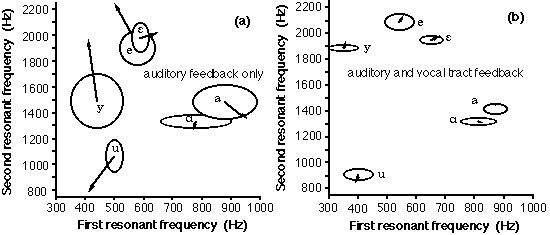
Fig. 4 shows that subjects who used vocal tract feedback
as well as auditory feedback produced values of R1 and R2
which were very similar to those of the target native speakers.
Tape recordings of the sounds made by the different groups
were played by a listening panel of native speakers who were
asked to identify the vowel sounds. The recognition rate was
significantly higher for the group using both types of feedback.
Conclusion
Auditory feedback is a model of standard language teaching in
which students hear a sound and attempt to imitate it. This
is a method that they have been using all their lives. Vocal
tract feedback, on the other hand, is a new type of feedback
and involves novel coordination between eye and articulation.
Nevertheless, one to two hours training with this feedback significantly
improved the articulation and comprehensibility of our subjects.
These preliminary results (to be reported in detail elsewhere)
suggest that RAVE has considerable potential in language laboratories
and in speech pathology.
Acknowledgements. We acknowledge support from the
Australian Research Council and thank our volunteer subjects.
Patent. The technology is the subject of provisional
patents and the authors would welcome enquiries from companies
interested in manufacturing the device.
References
- Clark, J. and Yallop, C. An Introduction to Phonetics
and Phonology, (Blackwell, Oxford 1990).
- Dowd, A. Real time non-invasive measurements of vocal
tract impedance spectra and applications to speech training.
Undergraduate thesis, Medical Physics, UNSW Sydney (1995).
- Dowd, A.; Smith, J. and Wolfe, J. Real time, non-invasive
measurements of vocal tract resonances: application to speech
training. Acoustics Australia 24: 53-60 (1996).
- Epps, J., Smith, J.R. and Wolfe, J. (1997) "A novel instrument
to measure acoustic resonances of the vocal tract during
speech" Measurement Science and Technology, 8, 1112-1121.
- Fletcher, N.H. Acoustic Systems in Biology (Oxford, NY
1992).
- Makhoul, J. Linear Prediction: A Tutorial Review. Proc.
IEEE 63: 561-579 (1975).
- Pham Thi Ngoc, Y. "Caracterisation acoustique du conduit
vocal: fonctions de transfert acoustiques et sources de
bruit" Doctoral thesis, Institut National Polytechnique
de Grenoble (1995).
- Pham Thi Ngoc, Y. and Badin, P. Vocal tract acoustic transfer
function measurements: further developments and applications.
J. de Physique IV C5: 549-552 (1994).
- Sundberg, J. The Science of the Singing Voice, (Northern
Illinois Univ. Press., De Kalb, Ill 1987).
- Wolfe, J. and Smith, J. A comparison of acoustic impedances
of flutes - a preliminary study. Intl. Symposium on Musical
Acoustics, Dourdan, France. 100-106 (1995).
- Wolfe, J., Smith, J.,Brielbeck. G., and Stocker, F. A
system for real time measurement of acoustic transfer functions.
Acoustics Australia 23: 19-20 (1995).
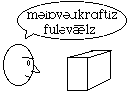
|

